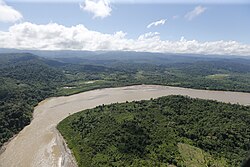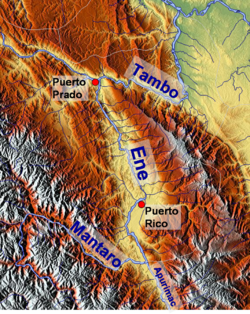Ene River
This article needs additional citations for verification. (December 2009) |


The Ene River (
headwater of the Amazon River
.
Geography
Headwaters
The Ene is formed at 12°15′45″S 73°58′30″W / 12.26250°S 73.97500°W at the confluence of the
Ayacucho
meet.
The river flows in a northwesterly direction at a total length of 180.6 km (112.2 mi).
The Ene River is part of the
Mismi, south of the city of Cusco where it first becomes Apurímac River, then the Ene River and Tambo River before its waters meet the Ucayali River
which later forms the Amazon.
At 11°09′39″S 74°14′48″W / 11.16083°S 74.24667°W the Ene River joins the Perené River at the town Puerto Prado, 295 m (968 ft) above sea level, and is called the Tambo from then on.
Threats
The proposed 2,200-megawatt Pakitzapango hydroelectric dam would flood much of the Ene River valley.Ruth Buendia (president since 2005) have halted the construction.[1][2] For her efforts, Buendia was awarded the Goldman Environmental Prize in 2014.[3][2]
References
- ^ a b "Pakitzapango Dam". International Rivers. Retrieved April 30, 2016.
- ^ a b Monti Aguirre (April 28, 2014). "Ruth Buendía of Peru Wins 2014 Goldman Environmental Prize". International Rivers. Retrieved April 30, 2016.
- ^ "Prize Recipient: Ruth Buendia, 2014 South & Central America". Goldman Environmental Prize. Retrieved 3 June 2014.
External links
 Media related to Ene River at Wikimedia Commons
Media related to Ene River at Wikimedia Commons
